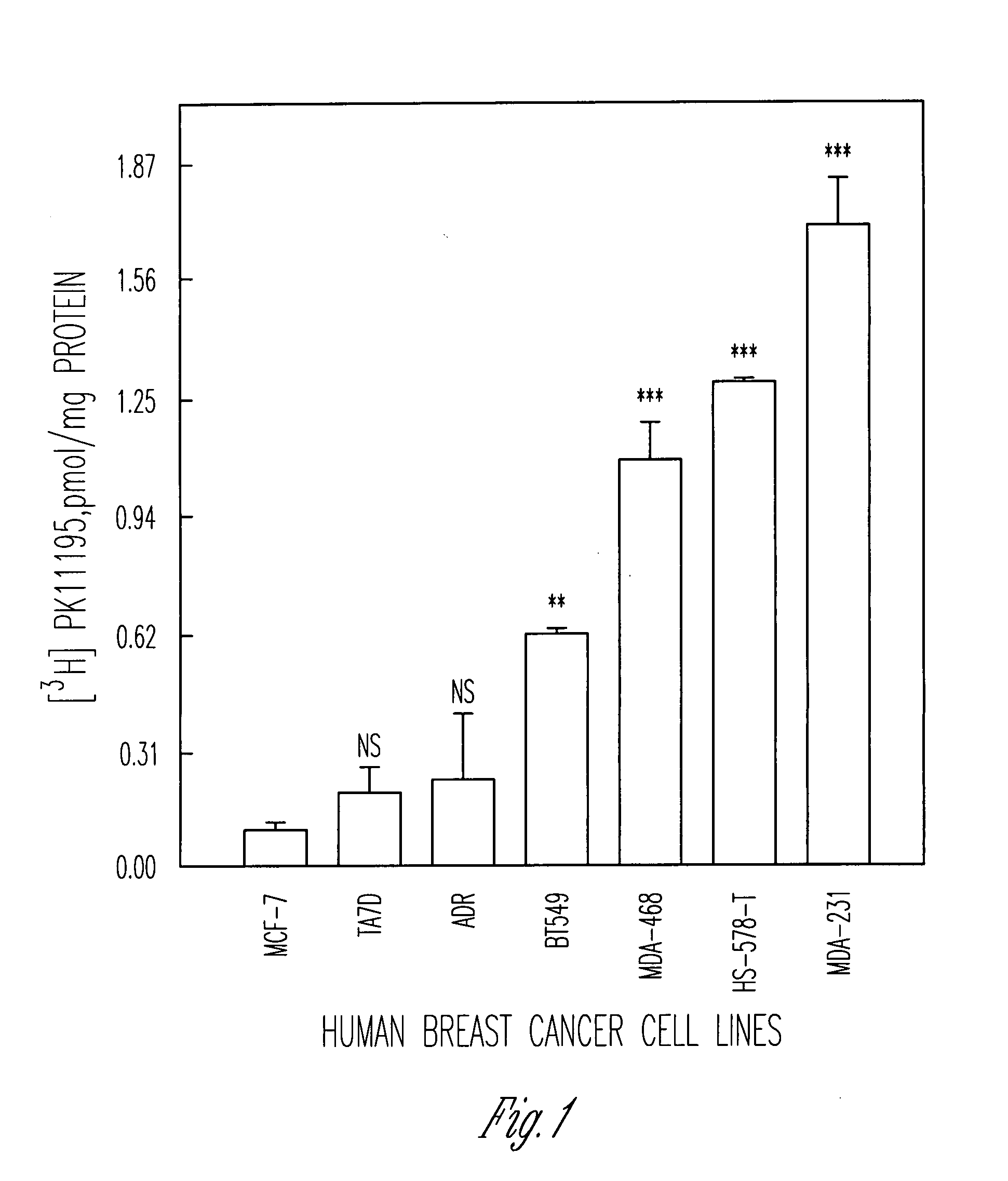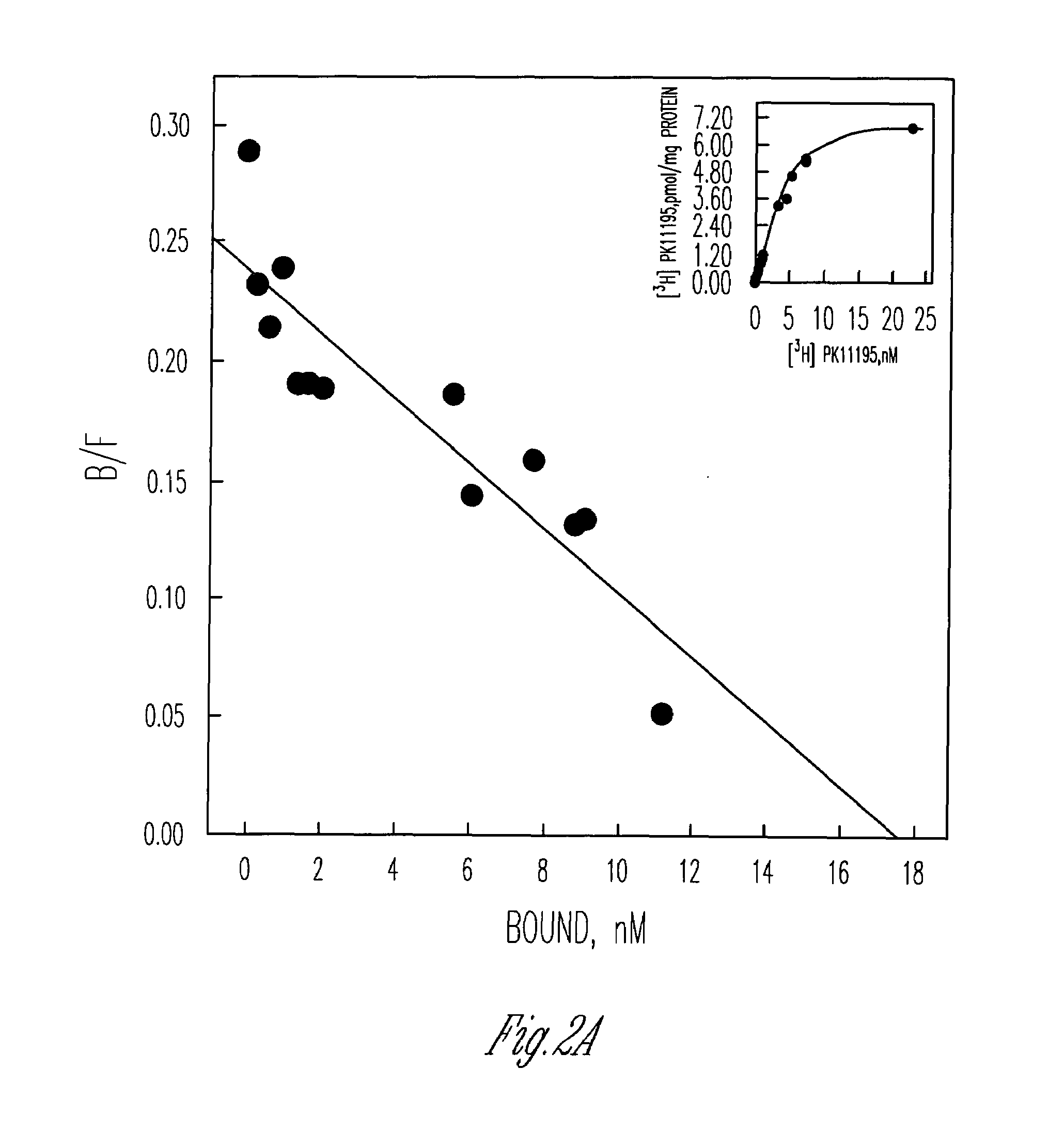Peripheral-type benzodiazepine receptor: a tool for detection, diagnosis, prognosis, and treatment of cancer
a benzodiazepine receptor and peripheral-type technology, applied in the field of peripheral-type benzodiazepine receptors, can solve the problems of cell proliferation reduction, reduce the function of pbr, inhibit the binding of pbr ligands, and reduce human breast cancer cell proliferation
- Summary
- Abstract
- Description
- Claims
- Application Information
AI Technical Summary
Benefits of technology
Problems solved by technology
Method used
Image
Examples
example 1
Increased Expression of the Peripheral-Type Benzodiazepine Receptor Corresponds With Increased Aggressive Phenotype in Human Breast Cancer Cell Lines
[0111]In order to establish a correlation between PBR expression and increased aggressive behavior in cancer we chose to examine this proposed phenomenon in human breast cancer. To this end, binding studies were initially performed on nine human breast cancer cell lines using the PBR-specific high affinity ligand PK11195. The results from these early experiments indicate that those cell lines with a more invasive and chemotactic potential such as HS-578-T and MDA-231 display dramatically increased levels of PBR binding relative to non-aggressive cell lines such as ZR-75-1, T47D, and MCF-7 (Table 1 and FIG. 1).
[0112]
TABLE 1Comparison of Invasive Characteristics ofHuman Breast Cancer Cell Lines to PBR Expression.CellEstrogenLineReceptorVimentinInvasionChemotaxisCD44PBRZR-75-1+−++−−T47D+−++−+MCF-7+−+ ++ +++MDA-435−++ + ++ ++ + ++ADR−++ + +...
example 2
PBR Found in the MDA-231 Human Breast Cancer Cell Line is Similar to PBR Found in Other Human Tissues
[0117]Given the numerous differences between both the expression and localization of PBR in MDA-231 cells and the other human breast cancer cell lines studied, as well as previous published reports, it became important to determine if we were dealing with the same receptor. The first step towards this end was to establish a pharmacological profile for MDA-231 PBR. Displacement of [3H] PK11195 by increasing concentrations of various PBR ligands is similar to the pharmacological profile previously reported for human PBR (FIG. 5) (Chang et al. (1992), supra). Next we obtained partial PBR cDNA sequences for both MDA-231 and MCF-7 PBR. The nucleotide sequences obtained revealed several point mutations resulting in two amino acid replacements replacing alanine 147 with a threonine and a replacing of histidine 162 with arginine in both MDA-231 and MCF-7. Given that this mutation occurs in b...
example 3
A Decrease in Cholesterol Uptake Into MDA-231 Nuclei Correlates With an Increase in Cell Proliferation
[0120]We have shown that PK11195 inhibits the uptake of cholesterol into the nucleus at nanomolar and low micromolar concentrations. We have also shown that PK11195 also stimulates cell proliferation at these concentrations. We were then interested in determining whether or not the regulation of nuclear cholesterol uptake correlates with the PBR-mediated regulation of cell proliferation. In order to determine such a relationship, all of the cholesterol data for given concentrations of PK11195 was plotted against all of the proliferation data at the same PK11195 concentrations. A regression line for all points gave a coefficient of correlation (r) of 0.75. Considering that −4M PK11195 is a toxic concentration, removal of the data from −4M PK11195 yields a coefficient of correlation (r) of 0.99 (FIG. 8).
PUM
| Property | Measurement | Unit |
|---|---|---|
| temperature | aaaaa | aaaaa |
| temperature | aaaaa | aaaaa |
| volume | aaaaa | aaaaa |
Abstract
Description
Claims
Application Information
 Login to View More
Login to View More - R&D
- Intellectual Property
- Life Sciences
- Materials
- Tech Scout
- Unparalleled Data Quality
- Higher Quality Content
- 60% Fewer Hallucinations
Browse by: Latest US Patents, China's latest patents, Technical Efficacy Thesaurus, Application Domain, Technology Topic, Popular Technical Reports.
© 2025 PatSnap. All rights reserved.Legal|Privacy policy|Modern Slavery Act Transparency Statement|Sitemap|About US| Contact US: help@patsnap.com



